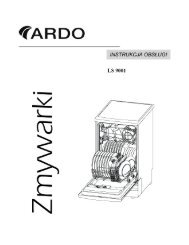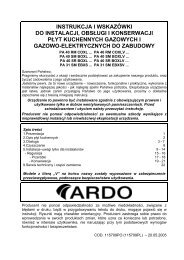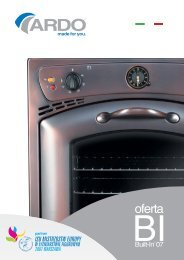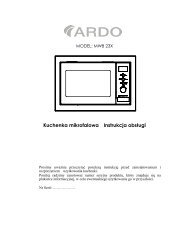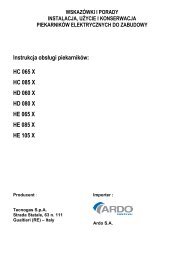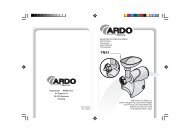DWI ) 10L6 ( GB - Ardo
DWI ) 10L6 ( GB - Ardo
DWI ) 10L6 ( GB - Ardo
You also want an ePaper? Increase the reach of your titles
YUMPU automatically turns print PDFs into web optimized ePapers that Google loves.
<strong>DWI</strong> <strong>10L6</strong> (<strong>GB</strong>)
For detailed operating method read the corresponding content on the instruction manual.<br />
Switch on the appliance Open the door,press the On/Off button to switch on the appliance .<br />
Fill the detergent dispenser<br />
Witheachwashcycle.<br />
Compartment<br />
For programmes with pre-wash only.<br />
(Follow the user instructions!)<br />
Check the rinse aid level<br />
Electric indicator on control panel (if provided).<br />
Check the regeneration<br />
salt level<br />
(On models with water softener system only.)<br />
Electric indicator on control panel (if provided).<br />
If there is no salt warning light in the control panel<br />
(for some models), you can estimate when to fill the salt into<br />
the softener by the number of cycles the dishwasher has run.<br />
Load the baskets<br />
Scrape off any large amount of leftover food. Soften remnants of burnt food in pans,<br />
then load the baskets. Refer to the dishwasher loading instructions.<br />
Select a programme<br />
Press the Programme Button until the selected programme lights up.<br />
( See the section entitled“ Operationg instruction ”)<br />
Running the dishwasher<br />
Turnonthewatertap ,closethedoor.Themachinewillstartworkingafterabout10seconds.<br />
Changing the programme<br />
Add forgotten dishes in the<br />
dishwasher.<br />
1. A running cycle can only be modified if it has been running for a short time. Otherwise the detergent<br />
may have already been released and the water already drained. If this is the case, the detergent<br />
dispenser must be refilled.<br />
2. Press the Programme Button for more than 3 seconds to cancel the running programme.<br />
3. Select a new programme.<br />
4. Restart the dishwasher.<br />
1.Open the door a little to stop the dishwasher.<br />
2.After the spray arms stop working, you can open the door completely.<br />
3.Add the forgotten dishes.<br />
4.Close the door, the dishwasher will start running again after 10 seconds.<br />
Open the door carefully.<br />
Hot steam may escape<br />
when the door is opened!<br />
If the appliance is switched<br />
off during a wash cycle.<br />
If the appliance is switched off during a wash cycle, when switched<br />
on again, please re-select the washing cycle and operate the dishwasher<br />
according to the original Power-on state ).<br />
Switch off the appliance<br />
When the working cycle has finished, the buzzer of the<br />
dishwasher will sound 8 times, then stop.<br />
Turn off the appliance using the On/Off Button.<br />
Turn off the water tap,<br />
unload the baskets<br />
Warning: wait a few minutes (about 15 minutes) before unloading the dishwasher to avoid handling<br />
the dishes and utensils while they are still hot and more susceptible to break.<br />
They will also dry better.Unload the appliance, starting from the lower basket.
Dear Customer,<br />
This appliance is intended to be used in household<br />
and similar applications such as:<br />
-staff kitchen areas in shops, offices and other<br />
working environments;<br />
-farm houses;<br />
-by clients in hotels, motels and other residential<br />
type environments;<br />
-bed and breakfast type environments.<br />
Please carefully read this manual before using the<br />
dishwasher, it will help you to use and maintain the<br />
dishwasher properly.<br />
Keep it as a refer in the later days.<br />
Pass it on to any subsequent owner of the appliance.<br />
This manual contains sections on safety Instructions,<br />
Operating Instructions, Installation Instructions and<br />
Troubleshooting Tips, etc.<br />
Control Panel...................................................3<br />
Dishwasher Features.................................... ...3<br />
A、<br />
Water Softener...........................................4<br />
B、<br />
Loading the Salt into the Softener.................5<br />
C、<br />
Fill the Rinse Aid Dispenser.........................5<br />
D、<br />
Function of Detergent .................................6<br />
Attention before or after loading the Dishwasher<br />
Baskets..........................................................9<br />
Loading the upper Basket...............................10<br />
Loading the Lower Basket...............................10<br />
Wash Cycle Table...........................................11<br />
Turning on the Appliance................................11<br />
Change the Programme.............. ....................12<br />
At the Ene of the Wash Cycle...........................12<br />
To review the section on troubleshooting Tips<br />
will help you to solve some common problems<br />
by yourself .<br />
If you can not solve the problems by yourself ,<br />
please ask for the help of professional technicians.<br />
Filtering System.............................................13<br />
Caring for the Dishwasher..................... ..........14<br />
Installation preparation.................................. 15<br />
Aesthetic panel's dimensions and installation...16<br />
Tension adjustment of the door spring..............18<br />
Connection of drain hoses.............................. 18<br />
Dishwasher installation steps......................... 19<br />
About Electricity Connecting...........................20<br />
Cold Water Connection.................................. 21<br />
Hot Water Connection..................... ............. 21<br />
The manufacturer, following a policy of constant<br />
development and updating of the product, may<br />
make modifications without giving prior notice.<br />
Before calling for service........................... ......22<br />
Error codes.................................... ...............23<br />
Technical information.............................. .......24
When using your dishwasher, follow the precautions listed below:<br />
This appliance must be grounded. In the event of a<br />
malfunction or breakdown, grounding will reduce<br />
the risk of anelectric shock by providing a path of<br />
least resistance of electric current. This appliance<br />
is equipped with a cord having an equipmentgrounding<br />
conductor and a grounding plug.<br />
The plug must be plugged into an appropriate outlet<br />
that is installed and grounded in accordance with<br />
all local codes and ordinances.<br />
Improper connection of the equipment-grounding<br />
conductor can result in the risk of an electric shock.<br />
Check with a qualified electrician or service<br />
representative if you are in doubt whether the<br />
appliance is properly grounded. Do not modify the<br />
plug provided with the appliance; If it does not fit<br />
the outlet. Have a proper outlet installed by a<br />
qualified electrician.<br />
Donotabuse,siton,orstandonthedoorordish<br />
rack of the dishwasher.<br />
Do not touch the heating element during or<br />
immediately after use.<br />
(This instruction is only applicable to machines<br />
with a visual heating element.)<br />
Do not operate your dishwasher unless all<br />
enclosure panels are properly in place. Open<br />
the door very carefully if the dishwasher is<br />
operating, there is a risk of water squirting out.<br />
Do not place any heavy objects on or stand on the<br />
door when it is open. The appliance could tip<br />
forward.<br />
When loading items to be washed:<br />
1) Locate sharp items so that they are not likely<br />
to damage the door seal;<br />
2)<br />
Warning: Knives and other utensils with<br />
sharp points must be loaded in the basket<br />
with their points down or placed in a<br />
horizontal position.<br />
When using your dishwasher, you should<br />
prevent plastic items from coming into contact<br />
with the heating element.(This instruction is only<br />
applicable to machines with a visual heating<br />
element.)<br />
Check that the detergent comparment is empty<br />
after completion of the wash cycle.<br />
Do not wash plastic items unless they are marked<br />
dishwasher safe or the equivalent. For plastic items<br />
not so marked, check the manufacturer's<br />
recommendations.<br />
Use only detergent and rinse additives<br />
designed for an automatic dishwasher.<br />
Never use soap, laundry detergent, or hand<br />
washing detergent in your dishwasher. Keep<br />
these products out of the reach of children.<br />
Keep children away from detergent and rinse aid, keep<br />
children<br />
away from the open door of the dishwasher,<br />
there could still be some detergent left inside.<br />
This appliance is not intended for use by persons<br />
(including children ) with reduced physical, sensory or<br />
mental capabilities, or lack of experience and<br />
knowledge ,unless they have been given supervision<br />
or instruction concerning use of the appliance by a<br />
person responsible for their safety.<br />
Children should be supervised to ensure that they do<br />
not play with the appliance.<br />
Dishwasher detergents are strongly alkaline, they<br />
can be extremely dangerous if swallowed. Avoid<br />
contact with skin and eyes and keep children away<br />
from the dishwasher when the door is open.<br />
The door should not be left open,<br />
since this could increase the risk of tripping.<br />
If the supply cord is damaged, it must be replaced<br />
bythemanufactureroritsserviceagentora<br />
similarly qualified person in order to avoid a<br />
hazard.<br />
Remove the door to the washing compartment when<br />
removing an old dishwasher from service or discarding it.<br />
Please dispose of packing materials properly.<br />
Use the dishwasher only for its intended function.<br />
During installation, the power supply must not<br />
be excessively or dangerously bent or flattened.<br />
Do not tamper with controls.<br />
The appliance is to be connected to the water<br />
mains using new hose sets and that old hose-sets<br />
should not be reused.<br />
The maximum number of place settings to be<br />
washed is 10.<br />
The maximum permissible inlet water pressure is<br />
1MPa.<br />
The minimum permissible inlet water pressure is<br />
0.04MPa.<br />
1
Dispose of the dishwasher packaging material correctly.<br />
All packaging materials can be recycled.<br />
Plastic parts are marked with the standard international abbreviations:<br />
PE for polyethylene, e.g. sheet wrapping material<br />
PS for polystyrene, e.g. padding material<br />
POM polyoxymethylene, e.g. plastic clips<br />
PP polypropylene, e.g. Salt filler<br />
ABS Acrylonitrile Butadiene Styrene, e.g. Control Panel .<br />
•<br />
•<br />
Packaging material could be dangerous for children!<br />
For disposing of package and the appliance please go to a recycling centre. Therefore cut<br />
off the power supply cable and make the door closing device unusable.<br />
Cardboard packaging is manufactured from recycled paper and should be disposed in the<br />
waste paper collection for recycling.<br />
By ensuring this product is disposed of correctly, you will help prevent potential negative<br />
consequences for the environment and human health, which could otherwise be caused<br />
by inappropriate waste handling of this product.<br />
For more detailed information about recycling of this product, please contact your local<br />
city office and your household waste disposal service.<br />
•<br />
•<br />
•<br />
DISPOSAL: Do not dispose this product as unsorted municipal waste. Collection of such<br />
waste separately for special treatment is necessary.<br />
2
To get the best performance from your dishwasher, read all operating instructions<br />
before using it for the first time.<br />
1 2 3 4 5 6<br />
7<br />
1h<br />
1.On/Off Button: To turn on/off the power supply.<br />
2.Program Button : To Press the button to select a<br />
wash Program.<br />
3.Power indicator: To show when the power on.<br />
6.Salt and rinse aid warning lights: To show<br />
when the salt container or dispenser need to be<br />
refilled<br />
7.Delay Button : To Press the button to delay;<br />
4.Program indicators: to show which program<br />
you have chose;<br />
5.Delay indicators: to show the delay time<br />
Front view<br />
Back<br />
View<br />
1<br />
2<br />
3<br />
4<br />
5<br />
6<br />
8<br />
9 10<br />
7<br />
11 12<br />
1 Top spray arm<br />
Inner pipe<br />
2<br />
3<br />
Cutlery rack<br />
Upper basket<br />
4<br />
5<br />
6<br />
Lower basket<br />
Salt container<br />
7<br />
8<br />
9<br />
Dispenser<br />
Cup shelf<br />
Spray arms<br />
10<br />
11<br />
12<br />
Filter assembly<br />
Inlet pipe connector<br />
Drain pipe<br />
3
Before using your dishwasher for the first time:<br />
A. Set the water softener<br />
B. Add 1.5Kg dishwasher salt and then full fill the salt container with water<br />
C. Filltherinseaiddispenser<br />
D. Fill in detergent<br />
The water softener must be set manually, using the water hardness dial.<br />
The water softener is designed to remove minerals and salts from the water, which would have<br />
a detrimental or adverse effect on the operation of the appliance.<br />
The higher the content of these minerals and salts, the harder your water is.<br />
The softener should be adjusted according to the hardness of the water in your area. Your local Water Authority<br />
can advise you on the hardness of the water in your area.<br />
Adjusting Salt Consumption<br />
The dishwasher is designed to allow for adjustment in the amount of salt consumed based on the hardness of<br />
the water used. This is intended to optimise and customise the level o f salt consumption.<br />
Please follow the steps below for adjustment in salt consumption.<br />
1. Open the door ,Switch on the appliance;<br />
2. Press the Program button for more than 5 seconds to start the water softener<br />
set model within 60seconds after the appliance was switched on( The Salt and<br />
Rinse aid warninglights will be on periodically when it get in the set model );<br />
3. Press the Program button to select the proper set according to your local environment,<br />
the sets will change in the following sequence: H1->H2->H3->H4->H5->H6;<br />
4. Press the Power button to end the set up model.<br />
dH<br />
fH<br />
WATER HARDNESS<br />
Clarke<br />
mmol/l<br />
Selector Position<br />
Salt consumption<br />
(gram/cycle)<br />
Auto nomy<br />
(cycles/1kgs)<br />
0~5 0~9<br />
0~6<br />
0~0.94 H1( Rapid ) 0 /<br />
6-11 10-20<br />
7-14<br />
1.0-2.0 H2(1Hour) 20 60<br />
12-17 21-30<br />
15-21<br />
2.1-3.0 H3(1Hour、 Rapid) 30 50<br />
18-22 31-40 22-28 3.1-4.0 H4(Glass) 40 40<br />
23-34 41-60<br />
29-42<br />
4.1-6.0 H5(Glass、 Rapid) 50 30<br />
35-55 61-98 43-69 6.1-9.8 H6(Glass、 1Hour) 60 20<br />
1 dH=1.25 Clarke=1.78 fH=0.178mmol/l<br />
DH: German degree<br />
fH: French degree<br />
Clark: British degree<br />
The manufactory setting: H4 (EN 50242)<br />
Contact your local water board for information on the hardness of your water supply.<br />
If your model does not have any water softener, you may skip this section.<br />
WATER SOFTENER<br />
The hardness of the water varies from place to place. If hard water is used in the dishwasher, deposits will<br />
form on the dishes and utensils.<br />
The appliance is equipped with a special softener that uses a salt container specifically designed to eliminate<br />
lime and minerals from the water.<br />
4
Always use the salt intended for use with dishwasher.<br />
The salt container is located beneath the lower basket and should be filled as explained<br />
in the following:<br />
Attention!<br />
Only use salt specifically designed for the use in dishwashers! Every other type of<br />
salt not specifically designed for the use in a dishwasher, especially table salt, will<br />
damage the water softener. In case of damages caused by the use of unsuitable<br />
salt the manufacturer does not give any warranty nor is liable for any damages caused.<br />
Only fill with salt just before starting one of the complete washing programs.<br />
This will prevent any grains of salt or salty water, which may have been spilled,<br />
remaining on the bottom of the machine for any period of time, which may cause<br />
corrosion.<br />
A After the lower basket has been removed, unscrew and remove the cap from the salt container.<br />
B Place the end of the funnel (supplied) into the hole and introduce about 1.5kg of dishwasher salt.<br />
C Full fill the salt container with water,It is normal for a small amount of water to come out of the<br />
salt container.<br />
D After filling the container , screw the cap tightly back clockwise.<br />
E The salt warning light will stop being after the salt container has been filled with salt.<br />
F Immediately after filling the salt into the salt container, a washing program should be started (We suggest to use a short<br />
program).<br />
Otherwise the filter system, pump or other important parts of the machine may be damaged<br />
by salty water. This is out of warranty.<br />
1. The salt container must only be refilled when the salt warning light in the control panel comes on.<br />
Depending on how well the salt dissolves, the salt warning light may still be on even though the<br />
salt container is filled.<br />
If there is no salt warning light in the control panel (for some Models),you can estimate when to fill<br />
the salt into the softener by the cycles that the dishwasher has run.<br />
2. If there are spills of the salt, a soak or a rapid program should be run to remove the excessive salt.<br />
Rinse Aid Dispenser<br />
The rinse aid is released during the final rinse to prevent water from forming droplets on your dishes, which can<br />
leave spots and streaks. It also improves drying by allowing water to roll off the dishes. Your dishwasher is<br />
designed to use liquid rinse aids. The rinse aid dispenser is located inside the door next to the detergent dispenser.<br />
To fill the dispenser, open the cap and pour the rinse aid into the dispenser until the level indicator turns completely<br />
black. The volume of the rinse aid container is about 110ml.<br />
Function of Rinse Aid<br />
Rinse aid is automatically added during the last rinse, ensuring thorough rinsing, and spot and streak free drying.<br />
Attention!<br />
Only use branded rinse aid for dishwasher. Never fill the rinse aid dispenser with any other substances<br />
(e.g. Dishwasher cleaning agent, liquid detergent). This would damage the appliance.<br />
5
When to Refill the Rinse Aid Dispenser<br />
If there is no rinse-aid warning light in the control panel, you can estimate the amount from the colour<br />
" "<br />
of the optical level indicator C located next to the cap. When the rinse-aid container is full, the whole<br />
indicator will be dark .As the rinse-aid diminishes, the size of the dark dot decreases. You should never let<br />
the rinse aid level fall 1 / 4 full.<br />
As the rinse aid diminishes, the size of the black dot<br />
on the rinse aid level indicator changes, as illustrated below.<br />
Full<br />
3/4full<br />
1/2full<br />
1 / 4 full - Should refill to eliminate spotting<br />
Empty<br />
1<br />
2<br />
3<br />
To open the dispenser, turn the cap to the "open" (left) arrow and lift it out.<br />
Pour the rinse aid into the dispenser, being careful not to overfill.<br />
Replace the cap by inserting it aligned with "open" arrow and turning it to the closed (right) arrow.<br />
Clean up any rinse aid spilled while during filling with an absorbent cloth to avoid excessive foaming<br />
during the next wash. Don't forget to replace the cap before you close dishwasher door.<br />
Adjusting Rinse Aid Dispenser<br />
The rinse aid dispenser has six or four settings. Always start with the dispenser<br />
set on "4". If spots and poor drying are a problem, increase the amount of rinse<br />
aid dispensed by removing the dispenser lid and rotating the dial to "5". If the<br />
dishes still are not drying properly or are show spots, adjust the dial to the next<br />
higher lever until your dishes are spot-free. The recommended setting is "4".<br />
(Factory value is "4".)<br />
Increase the dose if there are drops of water or lime spots on the dishes after washing.<br />
Reduce it if there are sticky whitish stains on your dishes or a bluish film on glassware or<br />
knife blades.<br />
Detergents with its chemical ingredients are necessary to remove dirt, crush dirt and transport it out of the dishwasher.<br />
Most of the commercial quality detergents are suitable for this purpose.<br />
Attention!<br />
Proper Use of Detergent<br />
Use only detergent specifically made for the use in dishwashers. Keep your detergent fresh and dry.<br />
Don't put powdered detergent into the dispenser until you're ready to wash dishes.<br />
6
Detergents<br />
There are 3 sorts of detergents<br />
1.With phosphate and with chlorine<br />
2.With phosphate and without chlorine<br />
3.Without phosphate and without chlorine<br />
Normally new pulverised detergent is without phosphate. Thus the water softener function of<br />
phosphate is not given. In this case we recommend to fill salt in the salt container even when<br />
the hardness of water is only 6 ° dH. If detergents without phosphate are used in the case of hard water<br />
often white spots appear on dishes and glasses. In this case please add more detergent to reach<br />
better results. Detergents without chlorine do only bleach a little. Strong and coloured spots will not<br />
be removed completely. In this case please choose a program with a higher temperature.<br />
Concentrated Detergent<br />
Based on their chemical composition, detergents can be split in two basic types:<br />
conventional, alkaline detergents with caustic components<br />
low alkaline concentrated detergents with natural enzymes<br />
Detergent Tablets<br />
Detergent tablets of different brands dissolve at different speeds. For this reason some<br />
detergent tablets cannot dissolve and develop their full cleaning power during short<br />
programs. Therefore please use long programs when using detergent tablets, to<br />
ensure the complete removal of detergent residuals.<br />
Detergent Dispenser<br />
The dispenser must be refilled before the start of each wash cycle following the instructions<br />
provided in the wash cycle table . Your dishwasher uses less detergent and rinse aid than<br />
Conventional dishwasher. Generally, only one tablespoon of detergent is needed for<br />
a normal wash load. More heavily soiled items need more detergent. Always add the<br />
detergent just before starting the dishwasher, otherwise it could get damp and will not<br />
dissolve properly.<br />
Amount of Detergent to Use<br />
Detergent powder<br />
Detergent tablet<br />
If the lid is closed: press release button. The lid will spring open.<br />
Always add the detergent just before starting each wash cycle.<br />
Only use branded detergent aid for dishwasher.<br />
Dishwasher detergent is corrosive! Take care to keep it out of reach of children.<br />
7
Fill in Detergent<br />
Fill the detergent dispenser with detergent.<br />
The marking indicates the dosing levels , as<br />
illustrated on the right:<br />
The place of main wash cycle detergent placed.<br />
A<br />
B<br />
The place of pre-wash cycle detergent placed.<br />
Please observe the manufacturers dosing and storage<br />
Recommendations as stated on the detergent packaging.<br />
Close the lid and press until it locks in place.<br />
If the dishes are heavily soiled, place an additional<br />
detergent dose in the pre-wash detergent chamber. This detergent will take effect during the pre-wash phase.<br />
You find information about the amount of detergent for the single programme on the last page.<br />
Please aware, that according to the level soiling and the specific hardness of water differences are possible.<br />
Please observe the manufacturer's recommendations on the detergent packaging.<br />
8
Consider buying utensils which are identified as dishwasher-proof.<br />
Use a mild detergent that is described as 'kind to dishes'. If necessary, seek further<br />
information from the detergent manufacturers.<br />
For particular items, select a program with as low a temperature as possible.<br />
To prevent damage, do not take glass and cutlery out of the dishwasher immediately<br />
after the programme has ended.<br />
Are not suitable<br />
Cutlery with wooden, horn china or<br />
mother-of-pearl handles<br />
Plastic items that are not heat resistant<br />
Older cutlery with glued parts that are not<br />
temperature resistant<br />
Bonded cutlery items or dishes<br />
Pewter or cooper items<br />
Crystal glass<br />
Steel items subject to rusting<br />
Wooden platters<br />
Items made from synthetic fibres<br />
Are of limited suitability<br />
Some types of glasses can become<br />
dull after a large number of washes<br />
Silver and aluminum parts have a<br />
tendency to discolour during washing<br />
Glazed patterns may fade if machine<br />
washed frequently<br />
(For best performance of the dishwasher, follow these loading guidelines.<br />
Features and appearance of baskets and cutlery baskets may vary from your model.)<br />
Scrape off any large amounts of leftover food. Soften remnants of burnt food in pans.<br />
It is not necessary to rinse the dishes under running water.<br />
Place objects in the dishwasher in following way:<br />
1.Items such as cups, glasses, pots/pans, etc. are faced downwards.<br />
2.Curved items, or ones with recesses, should be loaded aslant so that water can run off.<br />
3.All utensils are stacked securely and can not tip over.<br />
4.All utensils are placed in the way that the spray arms can rotate freely during washing.<br />
Very small items should not be washed in the dishwasher as they could easily fall out of the basket.<br />
Load hollow items such as cups, glasses, pans etc. With the opening facing downwards so that<br />
water cannot collect in the container or a deep base.<br />
Dishes and items of cutlery must not lie inside one another, or cover each other.<br />
To avoid damage to glasses, they must not touch.<br />
Load large items which are most difficult to clean into the lower basket.<br />
The upper basket is designed to hold more delicate and lighter dishware such as glasses, coffee<br />
and tea cups<br />
Long bladed knives stored in an upright position are a potential hazard!<br />
Long and/or sharp items of cutlery such as carving knives must be positioned<br />
horizontally in the upper basket.<br />
Please do not overload your dishwasher. This is important for good results and for<br />
reasonable consumption of energy.<br />
To prevent water dripping from the upper basket into the lower basket, we recommend that you<br />
empty the lower basket first and then the upper basket.<br />
9
The upper basket is designed to hold more delicate<br />
and lighter dishware such as glasses, coffee and<br />
tea cups and saucers, as well as plates, small bowls<br />
and shallow pans (as long as they are not too dirty).<br />
Position the dishes and cookware so that they will<br />
not get moved by the spray of water.<br />
We suggest that you place large items and the most<br />
difficult to clean items are to be placed into the lower<br />
basket: such as pots, pans, lids, serving dishes and<br />
bowls, as shown in the figure below. It is preferable to<br />
place serving dishes and lids on the side of the racks<br />
in order to avoid blocking the rotation of the top spray<br />
arm.<br />
Please be reminded that:<br />
Pots,servingbowls,etc,mustalwaysbeplacedtopdown.<br />
Deep pots should be slanted to allow water to flow out.<br />
The Bottom Basket features folding spikes so that larger or more pots and pans can be loaded.<br />
Adjusting the Upper Basket<br />
The height of the upper basket can be adjusted in order to<br />
create more space for large utensils both for the upper<br />
/lower basket. The height of the upper basket can be<br />
adjusted by placing the wheels on different height of the<br />
rails. Long items, serving cutlery, salad servers and knives<br />
should be placed on the shelf so that they do not obstruct<br />
therotationofthesprayarms..<br />
Folding back the cup shelives<br />
For better stacking of pots and pans,<br />
the spikes can be folded down as<br />
show in the picture right.<br />
Folding Spikes of Lower Basket<br />
For better stacking of pots and pans,<br />
the spikes can be folded down as<br />
show in the picture right.<br />
Cutlery should be placed in the cutlery basket with the handles at the bottom. If the rack has side baskets, the<br />
spoons should be loaded separately into the appropriate slots, especially long utensils should be placed in the<br />
horizontal position at the front of the upper basket as shown in the picture.<br />
Do not let any item extend through the bottom.<br />
Always load sharp utensils with the sharp point down!<br />
10
( ) Means: need to fill rinse into the Rinse-Aid Dispenser.<br />
Intensive<br />
For heaviest soiled crockery,<br />
and normally soiled pots、<br />
pans、<br />
dishes etc with dried<br />
on soiling.<br />
Pre-wash(50 ℃ )<br />
Pre-wash<br />
Wash (65 ℃ )<br />
Rinse<br />
Rinse(55 ℃ )<br />
Drying<br />
3/22g<br />
(or 3in1)<br />
130<br />
1.2<br />
16.8<br />
Pre-wash( 45 ℃ )<br />
Normal For normally soiled loads, Wash (50 ℃ ) 3/22g<br />
such as pots, plates,glasses Rinse<br />
(or 3in1)<br />
and lightly soiled pans. Rinse (60 ℃ )<br />
Drying<br />
Pre-wash<br />
Eco. Standard daily cycle for<br />
Wash (50 ℃ )<br />
normally soiled loads, such<br />
Rinse(60 ℃ )<br />
as pots、 plates、<br />
glasses.<br />
3/22g<br />
Drying<br />
(*EN 50242) (or 3in1)<br />
155<br />
165<br />
1.04<br />
0.83<br />
13.7<br />
9<br />
Glass<br />
1Hour<br />
1h<br />
Rapid<br />
For lightly soiled crockery<br />
and glass<br />
For lightly soiled loads that<br />
do not need excellent drying<br />
efficiency.<br />
A shorter wash for lightly<br />
soiled loads and quick wash.<br />
Pre-wash<br />
wash(40 ℃ )<br />
Rinse<br />
Rinse(60 ℃ )<br />
Drying<br />
Pre-wash(50 ℃ )<br />
Wash(60 ℃ )<br />
Rinse (60 ℃ )<br />
Drying<br />
Wash (40 ℃ )<br />
Rinse<br />
Rinse (45 ℃ )<br />
25g<br />
3/22g<br />
20g<br />
110 0.72 13.7<br />
60 0.87 9.6<br />
40<br />
0.45<br />
10<br />
*EN 50242 : This programme is the test cycle. The information for comparability test<br />
in accordance with EN 50242, as follows:<br />
Capacity: 10 setting<br />
Position Upper basket: upper wheels on rails<br />
Rinse aid setting: 6<br />
Pl:0.55w; Po:0.45w.<br />
Starting a cycle wash<br />
1 Draw out the lower and upper basket, load the dishes and push them back.<br />
It is commended to load the lower basket first, then the upper one (see the section entitled<br />
“ Loading the Dishwasher ”).<br />
2 Pour in the detergent (see the section entitled“ Salt, Detergent and Rinse Aid ”).<br />
3 Insert the plug into the socket. The power supply is 220-240 VAC /50 HZ, the specification<br />
of the socket is 10A 250VAC. Make sure that the water supply is turned on to full pressure.<br />
4 Open the door, press the ON/OFF Button, and the ON/OFF light will turn on.<br />
5 Press the program Button , the wash program will be changed as follows direction:<br />
Intensive->Normal->Eco->Glass->1Hour ->Rapid;<br />
If a program is selected, the response light will light. Then close the door, the dishwasher<br />
begins to start.<br />
11
1<br />
2<br />
Premise:<br />
A cycle that is underway can only be modified if it has only been running for a short time. Otherwise, the<br />
detergent may have already been released, and the appliance may have already drained the wash water.<br />
If this is the case, the detergent dispenser must be refilled (see the section entitled " Loading the<br />
Detergent " ).<br />
Open the door ,press the Program button more than 3 seconds , the machine will be in standby state,<br />
then you can change the program to the desired cycle setting (see the section entitled " Starting a<br />
wash cycle. . ." ).<br />
If you open the door during a wash cycle , the machine will pause. The program light will<br />
stop blinking and the buzzer will mooing every minute unless you close the door . After<br />
you close the door ,the machine will keep on working after 10 seconds.<br />
A forgotten dish can be added any time before the detergent cup opens.<br />
Open the door a little .<br />
Close the door<br />
1 4<br />
2<br />
After the spray arms stop working, you can open the door<br />
completely.<br />
3<br />
Add forgotten dishes.<br />
5<br />
The dishwasher will run after 10 seconds.<br />
When the working cycle has finished, the buzzer of the dishwasher will sound for 8 seconds, then stop. Turn off<br />
the appliance using the ON/OFF button, shut off the water supply and open the door of the dishwasher.<br />
Wait for a few minutes before unloading the dishwasher to avoid handling the dishes and utensils while they<br />
are still hot and more susceptible to breakage. They will also dry better.<br />
Switch Off the Dishwasher<br />
The program light is on but is not blinking, only in this case the programme has ended.<br />
1.Switch off the dishwasher by pressing the ON/OFF button.<br />
2.Turn off the water tap!<br />
Open the door carefully.<br />
Hot dishes are sensitive to knocks. The dishes should therefore be allowed to cool down around 15 minutes<br />
before removing from the appliance.<br />
Open the dishwasher's door, leave it ajar and wait a few minutes before removing the dishes. In this way they<br />
will be cooler and the drying will be improved.<br />
Unloading the dishwasher<br />
It is normal that the dishwasher is wet inside.<br />
Empty the lower basket first and then the upper one. This will avoid water dripping from the upper Basket onto<br />
the dishes in the lower one.<br />
Wash the arms inWhen soapyfollowing and warmthis water procedure and usefrom a softstep1 brushto tostep 3, the filter system will be removed;<br />
clean the jets. Replace them It is dangerous<br />
when following afterit rinsingto from Step them open<br />
3 thoroughly.<br />
the door when washing, because the hot water may scald you.<br />
to Step 1, the filter system will be installed.<br />
12
The filter prevents larger remnants of food or other objects from getting inside the pum.<br />
The residues may block the filter, in this case they must be removed.<br />
2<br />
1<br />
3<br />
Filter assembly<br />
The filter system consists of a coarse filter,a flat (Main filter)<br />
And a microfilter(Fine filter).<br />
Main filter 1<br />
Food and soil particles trapped in this filter are pulverized by a<br />
special jet on the lower spray arm and washed down to drain.<br />
Coarse filter2<br />
Larger items, such as pieces of bones or glass, that could block<br />
the drain are trapped in the coarse filter. To remove the items<br />
caught by the filter, gently squeeze the tap on the top of this<br />
filter and lift out.<br />
Fine filter 3<br />
This filter holds soil and food residues in the sump area and<br />
prevents it from being redeposit on the dishes during wash cycle.<br />
The filter efficiently removes food particles from the wash water, allowing it to be recycled during the cycle.<br />
For best performance and results, the filter must be cleaned regularly. For this reason, it is a good idea to<br />
remove the larger food particles trapped in the filter after each wash cycle by rinsing the semicircular filter and<br />
cup under running water. To remove the filter device, pull the cup handle in the upward direction.<br />
The dishwasher must never be used without the filters.<br />
Improper replacement of the filter may reduce the performance level of the appliance<br />
and damage dishes and utensils.<br />
1<br />
Step 1:<br />
Turn the filter in anti-clockwise direction,<br />
2<br />
Step 2:<br />
lift the filter assy up<br />
When following this procedure from step1 to step 2, the filter system will be removed;<br />
when following it from Step 2 to Step 1, the filter system will be installed.<br />
13
Remarks:<br />
- Inspect the filters for blocking after every time the dishwasher has been used.<br />
- By unscrewing the coarse filter, you can remove the filter system. Remove any food remnants and<br />
clean the filters under running water.<br />
Cleaning the Filter<br />
The entire filter assembly should be cleaned once a week.<br />
To clean the coarse filter and the fine filter, use a cleaning brush. Reassemble the filter parts as shown in the figures<br />
on the last page and reinsert the entire assembly in the dishwasher, positioning it in its seat and pressing downwards.<br />
When cleaning the filters, don't knock on them. Otherwise, the filters could be<br />
contorted and the performance of the dishwasher could be decreased.<br />
The control panel can be cleaned by using a lightly dampened cloth.<br />
After cleaning, make sure to dry it thoroughly.<br />
For the exterior, use a good appliance polish wax.<br />
Never use sharp objects, scouring pads or harsh cleaners on any part of the dishwasher.<br />
Cleaning The Door<br />
To clean the edge around the door, you should use only a soft warm, damp cloth.<br />
To avoid penetration of water into the door lock and electrical components, do not<br />
use a spray cleaner of any kind.<br />
Never use a spray cleaner to clean the door panel as it may damage the door lock<br />
and electrical components.<br />
Abrasive agents or some paper towels should not be used because of the risk of<br />
scratching or leaving spots on the stainless steel surface.<br />
Protect Against Freezing<br />
please take frost protection measures on the dishwasher in winter. Every time after washing cycles,<br />
please operate as follows:<br />
1.Cut off the electrical power to the dishwasher.<br />
2.Turn off the water supply and disconnect the water inlet pipe from the water valve.<br />
3.Drain the water from the inlet pipe and water valve. (Use a pan to gather the water)<br />
4.Reconnect the water inlet pipe to the water valve.<br />
5.Remove the filter at the bottom of the tub and use a sponge to soak up water in the sump.<br />
If your dishwasher cannot work because of the ice,<br />
please contact professional service persons.<br />
Cleaning the Spray Arms<br />
It is necessary to clean the spray arms regularly for hard<br />
water chemicals will clog the spray arm jets and bearings.<br />
To remove the upper spray arm, hold the nut, rotate the arm<br />
clockwise to remove it.<br />
To remove the lower spray arm, pull out the spray arm upward.<br />
Wash the arms in soapy and warm water and use a soft brush to<br />
clean the jets. Replace them after rinsing them thoroughly.<br />
14
After Every Wash<br />
After every wash, turn off the water supply to the<br />
appliance and leave the door slightly open so that<br />
moisture and odours are not trapped inside.<br />
Remove the Plug<br />
Before cleaning or performing maintenance, always<br />
remove the plug from the socket.<br />
No Solvents or Abrasive Cleaning<br />
To clean the exterior and rubber parts of the dishwasher,<br />
do not use solvents or abrasive cleaning products.<br />
Only use a cloth with warm soapy water.<br />
To remove spots or stains from the surface of the<br />
interior, use a cloth dampened with water an a little<br />
vinegar, or a cleaning product made specifically for<br />
dishwashers.<br />
When not in Use for a LongTime<br />
It is recommend that you run a wash cycle with the<br />
dishwasher empty and then remove the plug from the<br />
socket, turn off the water supply and leave the door of<br />
the appliance slightly open. This will help the door<br />
seals to last longer and prevent odours from forming<br />
within the appliance.<br />
Moving the Appliance<br />
If the appliance must be moved, try to keep it in the<br />
vertical position. If absolutely necessary, it can be<br />
positioned on its back.<br />
Seals<br />
Oneofthefactorsthatcauseodourstoforminthe<br />
dishwasher is food that remains trapped in the seals.<br />
Periodic cleaning with a damp sponge will prevent this<br />
from occurring.<br />
The installation of the pipes<br />
and electrical equipments<br />
should be done by professionals.<br />
Electrical Shock Hazard<br />
Disconnect electrical power before<br />
installing dishwasher.<br />
Failuretodosocanresultindeathor<br />
electrical shock.<br />
●<br />
Installation preparation<br />
The installation position of dishwasher should be near the existing inlet and drain hoses and<br />
power cord.<br />
One side of the cabinet sink should be chosen to facilitate the connection of drain hoses of<br />
the dishwasher.<br />
Note: please check the accompanying installation accessories(hook for aesthetic panel,screw)<br />
15
Please carefully read the installation instruction.<br />
Illustrations of cabinet dimensions and installation position of the dishwasher<br />
1<br />
2<br />
Preparations should be made before moving the dishwasher to the installation place.<br />
Choose a place near the sink to facilitate the installation of inlet and drain hoses<br />
(see figure 1).<br />
If dishwasher is installed at the corner of the cabinet, there should be some space<br />
(illustrated in figure 2) when the door is opened.<br />
【 Figure1】<br />
Cabinet dimensions<br />
Less than 5mm<br />
between the top<br />
of dishwasher and<br />
cabinet and the<br />
outer door aligned<br />
to cabinet.<br />
820mm<br />
90 ° 90 °<br />
580mm<br />
Electrical, drain and<br />
water supply line<br />
entrances<br />
80<br />
100<br />
Space between cabinet<br />
bottom and floor<br />
450 mm<br />
【 Figure2】<br />
Minimum space when<br />
the door is opened<br />
Dishwasher<br />
Door of<br />
dishwasher<br />
Cabinet<br />
Minimum space of 50mm<br />
● Aesthetic panel's dimensions and installation<br />
1 The aesthetic wooden panel could be processed according to the Figure 3.<br />
449<br />
416±<br />
0.2<br />
390±<br />
0.2<br />
287.5±<br />
0.2<br />
2- 2dp8<br />
5<br />
【 Figure3】<br />
The aesthetic panel should<br />
be processed in accordance<br />
with the illustrated dimensions<br />
20( MAX)<br />
38 8- 2 dp8<br />
286<br />
4- 2 dp8<br />
(Unit: mm)<br />
16
2 Install the hook on the aesthetic wooden panel and put the hook into the slot of the outer door of<br />
dishwasher(see figure 4a). After positioning of the panel , fix the panel onto the outer door by<br />
screws and bolts(See figure 4b) .<br />
【 Figure4a】<br />
Installation of aesthetic panel<br />
【 Figure4b】<br />
Installation of aesthetic<br />
wooden panel<br />
1<br />
2<br />
. take away the four<br />
short screws<br />
. pin up the four long<br />
screws<br />
17
●<br />
Tension adjustment of the door spring<br />
The door springs are set at the factory to the proper tension for the outer door.<br />
If aesthetic wooden panel are installed, you will have to adjust the door spring tension.<br />
Rotate the adjusting screw to drive the adjustor to strain or relax the steel cable<br />
(see figure 5).<br />
Door spring tension is correct when<br />
the door remains horizontal in the<br />
fully opened position,<br />
yet rises<br />
toaclosewiththeslightliftofa<br />
finger.<br />
【 Figure5】<br />
Tension adjustment<br />
of the door spring<br />
●<br />
Connection of drain hoses<br />
Insert the drain hose into a drain pipe with a minimum diameter of 40mm, or let it run into the sink, making sure to<br />
avoid bending or crimping it. The top of the hose must be less than 1000mm.<br />
Front<br />
Counter<br />
NOTE<br />
The top of the hose<br />
must be less than<br />
1000mm.<br />
A<br />
Drain pipe<br />
B<br />
【Figure 6】<br />
φ 40mm<br />
18
●<br />
Dishwasher installation steps<br />
1 Install the furniture door to the outer door of the dishwasher using the brackets provided. Refer<br />
to the template for positioning of the brackets.<br />
2 Adjust the tension of the door springs by using an Allen key turning in a clockwise motion to<br />
tighten the left and right door springs. Failure to do this could cause damage to your dishwasher<br />
(Illustration 2).<br />
3 Connect the inlet hose to the cold water supply .<br />
4 Connect the drain hose. Refer to diagram.(Figure 6)<br />
5 Connect the power cord.<br />
6 Affix the condensation strip under the work surface of cabinet. Please ensure the condensation<br />
strip is flush with edge of work surface.<br />
7 Place the dishwasher into position.(Illustration 4)<br />
8 Level the dishwasher. The rear food can be adjusted from the front of the dishwasher by turning<br />
the Allen screw in the middle of the base of dishwasher use an Allen key (Illustration 5A). To adjust<br />
the front feet, use a flat screw driver and turn the front feet until the dishwasher is level (Illustration 5B).<br />
9 The dishwasher must be secured in place. There are two ways to do this:<br />
A. Normal work surface:Put the right(left) installation hook into the slot of the right(left) side plane and<br />
secure it to the work surface with two woodscrews (Illustration 6).<br />
B. Marble or granite work top:Bend the right(left) installation hook into right-angle,and put it into the<br />
slot of the right(left) side plane and secure it to the work surface with two woodscrews s (Illustration 7).<br />
【Figure 7】<br />
19
Dishwasher must be level for proper dish rack operation and wash performance.<br />
1 Place a spirit level on door and rack track inside the tub as shown to check that the<br />
dishwasher is level.<br />
2 level the dishwasher by adjusting the three levelling legs individually.<br />
3 When level the dishwasher, please pay attention not to let the dishwasher tip over.<br />
【 Figure 8】<br />
Illustration of feet adjustment<br />
NOTE:<br />
The maximum adjustment<br />
height of the feet is 50 mm.<br />
Check level Front to Back<br />
Spirit level<br />
Check level side to side<br />
For personal safety:<br />
DO NOT USE AN EXTENSION CORD OR AN ADAPTER PLUG WITH THIS APPLIANCE.<br />
DO NOT, UNDER ANY CIRCUMSTANCES, CUT OR REMOVE THE EARTHING<br />
CONNECTION FROM THE POWER CORD.<br />
Please look at the rating label to know the rating voltage and connect the dishwasher to the appropriate power supply.<br />
Use the required fuse 10 amp, time delay fuse or circuit breaker recommended and provide separate circuit serving<br />
only this appliance.<br />
Ensure the voltage and frequency of the power being corresponds to<br />
those on the rating plate. Only insert the plug into an electrical socket which is earthed<br />
properly. If the electrical socket to which the appliance must be connected is not<br />
appropriate for the plug , replace the socket, rather than using a adaptors or the like as<br />
they could cause overheating and burns.<br />
This appliance must be earthed. In the event<br />
of a malfunction or breakdown, earthing will<br />
reduce the risk of electric shock by providing a<br />
path of least resistance for the electric current.<br />
This appliance is equipped with a cord having an<br />
equipment-earthing conductor and an earthing<br />
plug. The plug must be plugged into an appropriate<br />
outlet that is installed and earthed in accordance<br />
with all local standards and requirements.<br />
Improper connection of the equipmentgrounding<br />
conductor can result in the risk<br />
of an electric shock. Check with a qualified<br />
electrician or service representative if you<br />
are in doubt whether the appliance is properly<br />
grounded. Do not modify the plug provided with<br />
theappliance;Ifitisnotfit fortheoutlet.<br />
Have a proper outlet installed by a qualified<br />
electrician.<br />
20
Connect the cold water supply hose to a threaded 3/4(inch) connector and make sure<br />
that it is fastened tightly in place.<br />
If the water pipes are new or have not been used for an extended period of time, let the<br />
water run to make sure that the water is clear. This precaution is needed to avoid the<br />
risk of the water inlet to be blocked and damage the appliance.<br />
please close the hydrant after using.<br />
Positioning the Appliance<br />
Position the appliance in the desired location. The back should rest against the wall behind it, and the sides,<br />
along the adjacent cabinets or walls. The dishwasher is equipped with water supply and drain hoses that can<br />
be positioned either to the right or the left sides to facilitate proper installation.<br />
How to Drain Excess Water From Hoses<br />
If the sink is 1000 higher from the floor, the excess water in hoses cannot be drained directly<br />
into the sink. It will be necessary to drain excess water from hoses into a bowl or suitable<br />
container that is held outside and lower than the sink.<br />
Water Outlet<br />
Connect the water drain hose. The drain hose must be correctly fitted to avoid water leaks.<br />
Ensure that the water inlet hose is not kinked or squashed.<br />
Extension Hose<br />
If you need a drain hose extension, make sure to use a similar drain hose.<br />
It must be no longer than 4 metres; otherwise the cleaning effect of the dishwasher could be reduced.<br />
Syphon Connection<br />
Insert the drain hose into a drain pipe with a minimum diameter of 40mm, or let it run into the sink, making sure to<br />
avoid bending or crimping it. The top of the hose must be less than 1000mm.<br />
The following things should be checked before starting the dishwasher.<br />
1 The dishwasher is level and fixed properly<br />
2 The inlet valve is open<br />
3 There is a leakage at the connections of the conducts<br />
4 The wires are tightly connected<br />
5 The power is switched on<br />
6 The inlet and drain hoses are knotted<br />
7 All packing materials and printings should be taken out from the dishwasher<br />
After installation, please make sure to keep this manual.<br />
The content of this manual is very helpful to the users.<br />
21
Fuse blown, or the<br />
circuit breaker acted<br />
Power supply is not<br />
turned on<br />
Water pressure is low<br />
Door of dishwasher<br />
not properly closed.<br />
Kink in drain hose<br />
Filter clogged<br />
Kitchen sink clogged<br />
Improper detergent<br />
Spilled rinse-aid<br />
Detergent with<br />
colourant was used<br />
Hard water minerals<br />
The affected items are<br />
not corrosion resistant.<br />
Replace fuse or reset circuit breaker. Remove any other<br />
appliances sharing the same circuit with the dishwasher<br />
Make sure the dishwasher is turned on and the door is<br />
closed securely.<br />
Make sure the power cord is properly plugged into the<br />
wall socket.<br />
Check that the water supply is connected properly and<br />
the water is turned on.<br />
Make sure to close the door properly and latch it.<br />
Check drain hose.<br />
Check coarse the filter<br />
(see section titled " Cleaning The Filter ")<br />
Check the kitchen sink to make sure it is draining well.<br />
If the problem is the kitchen sink not draining ,you may<br />
need a plumber rather than a serviceman for dishwashers.<br />
Use only the special dishwasher detergent to avoid suds.<br />
If this occurs, open the dishwasher and let suds evaporate.<br />
Add 1 gallon of cold water to the tub. Close and latch the<br />
dishwasher, then select any cycle. Dishwasher will drain<br />
out the water at the first step.Open the door after draining<br />
is stop and check if the suds is disappeared.<br />
Repeat if necessary.<br />
Always wipe up rinse-aid spills immediately.<br />
Make sure that the detergent is the one without<br />
colourant.<br />
To clean the interior, use a damp sponge with<br />
dishwasher detergent and wear rubber gloves.<br />
Never use any other cleaner than dishwasher<br />
detergent for the risk of foaming or suds.<br />
A programme was not Always run the quick wash programme .<br />
run after dishwasher without any crockery in the dishwasher and<br />
salt was added. without selecting the Turbo function (if present),<br />
Traces of salt have after adding dishwasher salt.<br />
gotten into the wash cycle.<br />
The lid of the softer<br />
is loose<br />
Aspayarmis r<br />
knocking against<br />
an item in a basket<br />
Items of crockery<br />
are loose in the<br />
wash cabinet<br />
This may be caused<br />
by on-site installation<br />
or the cross-section of<br />
the piping.<br />
Check the lip .Ensure the fix is fine.<br />
Interrupt the programme, and rearrange the items<br />
which are obstructing the spray arm.<br />
Interrupt the programme,<br />
and rearrange the items of crockery.<br />
This has no influence on the dishwasher function.<br />
if in doubt, contact a suitably qualified plumber.<br />
22
The dishes were not<br />
loaded correctly.<br />
The programme was<br />
not powerful enough.<br />
Not enough detergent<br />
was dispensed.<br />
Items are blocking<br />
the path of spray arms.<br />
The filter combination<br />
inthebaseofwash<br />
cabinet is not clean or<br />
is not correctly fitted.<br />
This may cause<br />
the spray arm jets<br />
to get blocked.<br />
Combination of soft<br />
water and too much<br />
detergent.<br />
Aluminum utensils<br />
have rubbed against<br />
dishes.<br />
Dishes block<br />
detergent cups.<br />
Improper loading<br />
See notes in " Loading the Dishwasher Baskets ".<br />
Select a more intensive programme.<br />
See" Wash Cycle Table ".<br />
Use more detergent, or change your detergent.<br />
Rearrange the items so that the spray can rotate freely.<br />
Clean and/or fit the filter combination correctly.<br />
Clean the spray arm jets. See "Cleaning the Spray<br />
Arms".<br />
Use less detergent if you have soft water and select<br />
a shortest cycle to wash the glassware and to get<br />
them clean.<br />
Use a mild abrasive cleaner to eliminate those marks.<br />
Re-loading the dishes properly.<br />
Load the dishwasher as suggested in the directions.<br />
Too little rinse-aid<br />
Dishes are removed<br />
too soon<br />
Wrong program<br />
has been selected<br />
Use of cutlery with<br />
a low-quality coating<br />
Increase the amount of rinse-aid/refill the rinse-aid<br />
dispenser.<br />
Do not empty your dishwasher immediately after<br />
washing. Open the door slightly so that the steam can<br />
escape. Begin unloading the dishwasher only once t<br />
he dishes are barely warm to the touch. Empty the low<br />
basket first. This prevents water form dropping off<br />
dishes in the upper basket.<br />
In short program the washing temperature is lower.<br />
This also lowers cleaning performance. Choose<br />
a program with a long washing time.<br />
Water drainage is more difficult with these items.<br />
Cutlery or dishes of this type are not suitable for<br />
washing in the dishwasher.<br />
When some malfunctions come on, the appliance will display error codes to warn you:<br />
The Rapid light flicker fleetly<br />
The Glass light flicker fleetly<br />
Longer inlet time.<br />
Overflow.<br />
Faucets is not opened, or water intake is<br />
restricted,or water pressure is too low.<br />
Some element of dishwasher leaks .<br />
23
If overflow occurs, turn off the main water supply before calling a service.<br />
If there is water in the base pan because of an overfill or small leak,<br />
the water should be removed before restarting the dishwasher.<br />
Height :<br />
815mm<br />
Width :<br />
448 mm<br />
Depth : 550mm( with the door closed)<br />
Power supply:<br />
see rating label<br />
Capacity:<br />
10 place settings<br />
24
Technical Data Sheet<br />
Sheet of household dishwasher according to EU Directive 1059/2010:<br />
Manufacturer<br />
Type / Description<br />
Standard place settings<br />
Energy efficiency class<br />
Annual energy consumption<br />
Energy consumption of the standard cleaning cycle<br />
Power consumption of off-mode<br />
Power consumption of left-on mode<br />
Annual water consumption<br />
Drying efficiency class<br />
Standard cleaning cycle<br />
Program duration of the standard cleaning cycle<br />
Noise level<br />
Mounting<br />
Could be built-in<br />
Height<br />
Width<br />
Depth (with connectors)<br />
Power consumption<br />
Rated voltage / frequency<br />
Water pressure (flow pressure)<br />
ARDO<br />
<strong>DWI</strong><strong>10L6</strong><br />
10<br />
A+<br />
238 kWh<br />
0.83 kWh<br />
0.45 W<br />
0.55 W<br />
2520 liter<br />
A<br />
Eco 50℃<br />
165 min<br />
49 dB(A) re 1 pW<br />
build under<br />
Yes<br />
81.5 cm<br />
44.8 cm<br />
55 cm<br />
1930 W<br />
220-240 V~ 50 Hz<br />
0.4-10 bar = 0.04-1 MPa<br />
NOTE:<br />
A + + + (highest efficiency) to D (lowest efficiency)<br />
Energy consumption “ 238”<br />
kWh per year, based on 280 standard cleaning cycles using cold water fill and<br />
the consumption of the low power modes. Actual energy consumption will depend on how the appliance is used.<br />
Water consumption “ 2520”<br />
litres per year, based on 280 standard cleaning cycles. Actual water consumption<br />
will depend on how the appliance is used.<br />
A (highest efficiency) to G (lowest efficiency)<br />
This program is suitable for cleaning soiled normally soiled tableware and that it is the<br />
most efficient programme in terms of its combined energy and water consumption for<br />
that type of tableware.<br />
The device meets the European standards and the directives in the current version at delivery:<br />
- LVD 2006/95/EC<br />
- EMC2004/108/EC<br />
- EUP 2009/125/EC<br />
The above values have been measured in accordance with standards under specified operating conditions.<br />
Results may vary greatly according to quantity and pollution of the dishes, water hardness,<br />
amount of detergent, etc.<br />
The manual is based on the European Union's standards and rules.<br />
25






